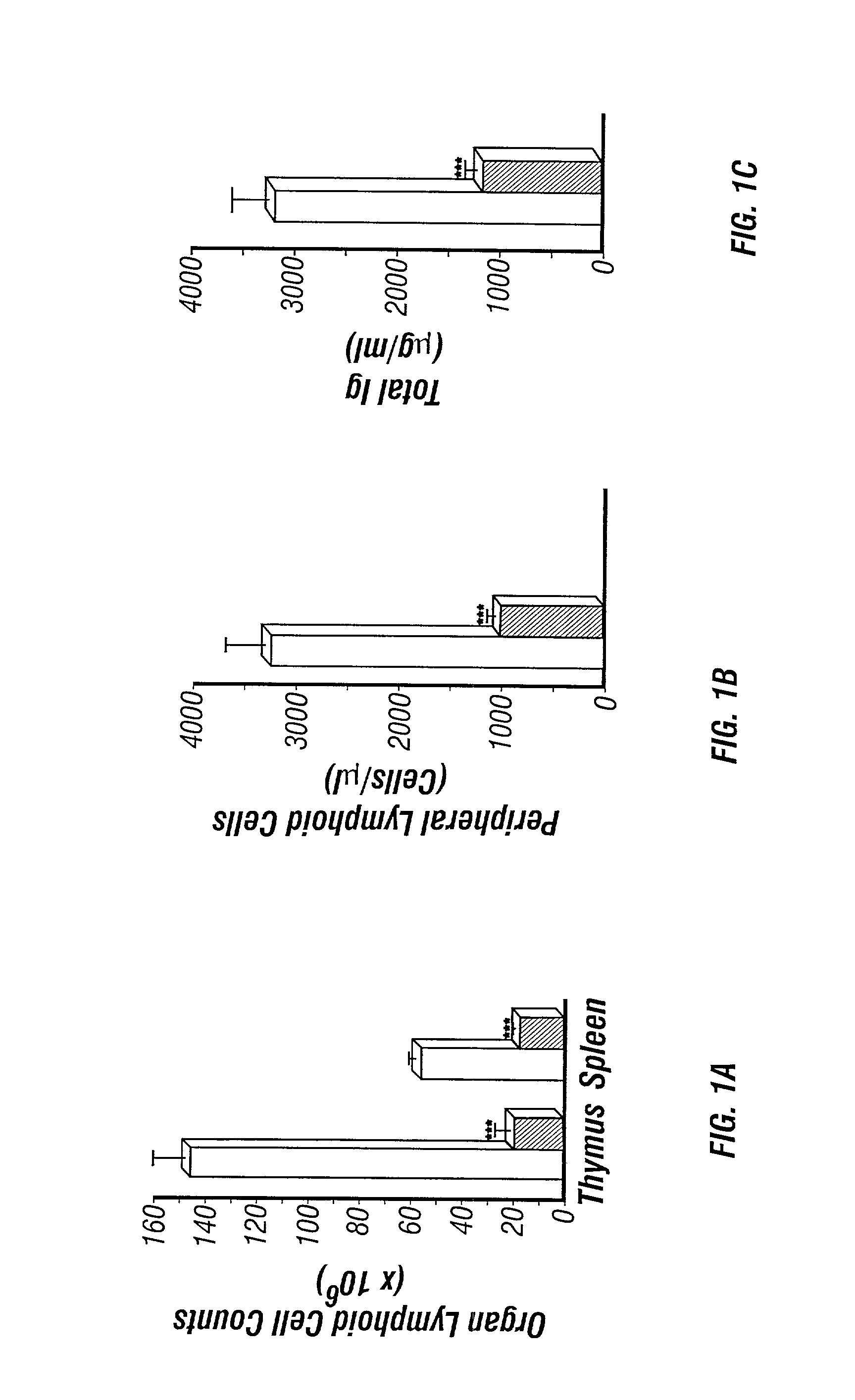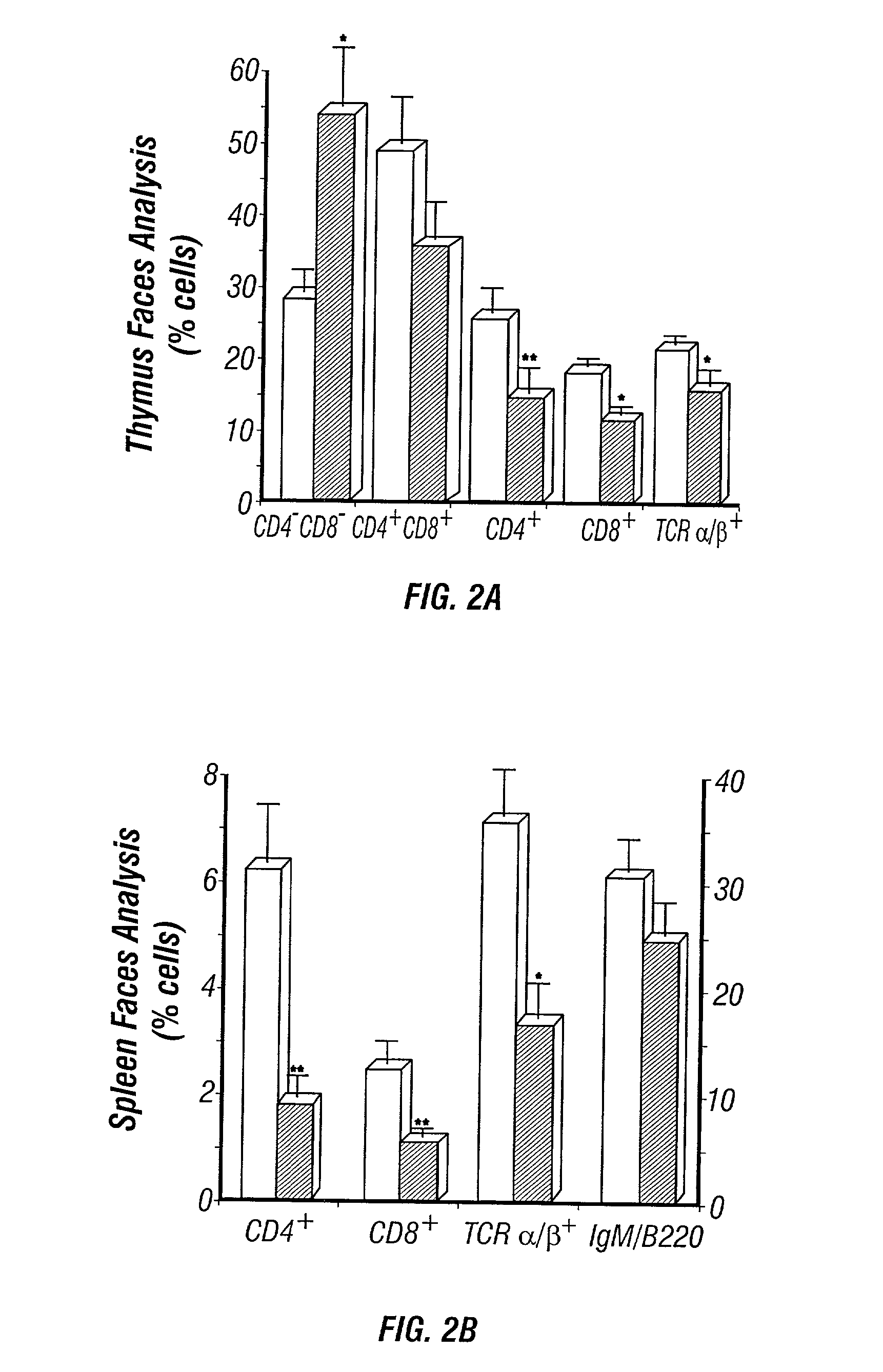Adenosine deaminase deficient transgenic mice and methods for the use thereof
a technology of adenosine deaminase and transgenic mice, which is applied in the field of adenosine deaminase (ada) deficient mice, can solve the problems of not being able to produce viable ada deficient mice, liver damage and subsequent death of ada deficient fetuses, and not being able to satisfy the specificity of lymphoid specificity of this metabolic diseas
- Summary
- Abstract
- Description
- Claims
- Application Information
AI Technical Summary
Benefits of technology
Problems solved by technology
Method used
Image
Examples
example 1
5.1 Example 1
Adenosine Deaminase Deficient Mice Generated Using a Two Stage Genetic Engineering Strategy Exhibit a Combined Immunodeficiency
[0469] The perinatal death of ADA deficient fetuses precluded the inventors' ability to assess the consequences of ADA deficiency in postnatal animals. In this example, the inventors describe the use of a transgenic strategy to rescue ADA deficient fetuses from perinatal lethality by restoring Ada expression to trophoblast cells. This procedure led to the development of postnatal animals that were completely ADA deficient These ADA deficient mice retain many features seen in ADA deficient humans, in particular a severe lymphopenia and combined immunodeficiency. In addition, ADA deficient mice develop severe pulmonary insufficiency, and bone and kidney abnormalities were detected. The ability to examine metabolic disturbances in a variety of tissues of ADA deficient mice revealed a widespread accumulation of adenosine, while 2'-deoxyadenosine acc...
example 2
5.2 Example 2
ADA Deficient Mice Rescued by Placental Expression Develop Significant Lung Eosinophillia and Lung Damage at an Early Age
[0500] 5.2.1 Materials and Methods
[0501] 5.2.1.1 Histological Analysis and Immunofluorescence
[0502] At the appropriate age, animals were sacrificed and the lungs infused with 0.25 to 0.5 ml of fixative (4% paraformaldehyde in PBS). Infused lungs were then placed in fixative overnight at 4 degrees C., rinsed in PBS, dehydrated and embedded in paraffin according to standard techniques. 5 micron sections were collected on microscope slides and stained with H&E (Shandon-Lipshaw) or PAS (EM Science) according to manufacturers instructions. Immunofluorescence of lungs for the expression of mMPB-1 was performed according to established procedures (Lee et al., 1997). Sections were reacted with antiserum from a rabbit immunized with purified mMBP-1, followed by detection using FITC-conjugated anti-rabbit IgG. Slides were viewed and photographed using an Olympu...
example 3
5.3 Example 3
The Eosinophilia and Lung Damage Seen in ADA Deficient Mice is Reversible and Dependent on the Levels of Adenosine in the Lung
[0512] 5.3.1 Materials and Methods
[0513] 5 5.3.1.1 ADA Enzyme Therapy and Zymogram Analysis of ADA Enzyme Activity
[0514] PEGADA, also known as ADAGEN, was obtained through collaboration with Enzon Inc. (Piscataway, N.J.). Control or ADA deficient mice were lightly anesthetized and injected intramuscularly with 10 microlitetrs of PEGADA corresponding to approximately 2.5 Units of ADA. Injections were given either chronically every 4 days starting at postnatal day 4, or acutely, as one injection on postnatal day 18. Levels of ADA enzyme activity in tissues was measured using zymogram analysis according to established procedures (Blackburn et al., 1998). This procedure visualizes enzyme activity on non-denaturing agarose gels (Blackburn et al., 1998).
[0515] 5.3.1.2 Quantification of Adenosine
[0516] Mice were anesthetized with avertin, the thoracic c...
PUM
| Property | Measurement | Unit |
|---|---|---|
| pH | aaaaa | aaaaa |
| pH | aaaaa | aaaaa |
| volumes | aaaaa | aaaaa |
Abstract
Description
Claims
Application Information
 Login to View More
Login to View More - R&D
- Intellectual Property
- Life Sciences
- Materials
- Tech Scout
- Unparalleled Data Quality
- Higher Quality Content
- 60% Fewer Hallucinations
Browse by: Latest US Patents, China's latest patents, Technical Efficacy Thesaurus, Application Domain, Technology Topic, Popular Technical Reports.
© 2025 PatSnap. All rights reserved.Legal|Privacy policy|Modern Slavery Act Transparency Statement|Sitemap|About US| Contact US: help@patsnap.com



